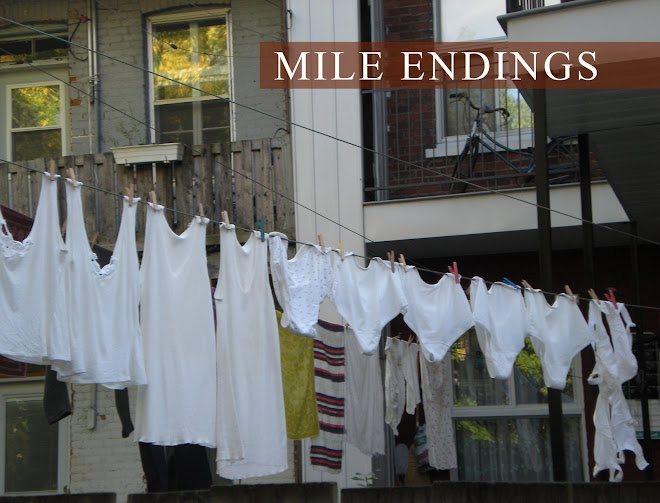
Past the east end of St. Viateur and beyond a gap in a chain link fence, between the factory buildings and the railroad tracks, there's a grassy vacant lot crisscrossed with dirt paths.
This lot, a huge expanse of open space by Mile End standards, has been attracting attention lately, in part because of Emily Rose Michaud.
If you talk to her, she'll tell you it's not actually vacant at all.
"It's a wild space in the middle of the city," she declares. Emily and the other neighbourhood proponents of the area call it the Roerich Garden, The Maguire Meadow or The Field of Possibilities/Le Champs des Possibles, and despite its contamination from having been a railway yard, they say it has its own ecosystem and habitat.
Originally owned by CP Rail, lot #2334609 was acquired by the city in June of this year and plans for its development are under discussion.
Emily, who is 26, grabs my pen as we talk and makes sketches on my notepad to emphasize and illustrate her points. She says I caught her on a high-energy morning, but it's hard to imagine her lethargic.
She was initially drawn to the wide open space as an art student and enjoyed walking through it along with the dog walkers, workers from buildings on Casgrain and de Gaspé and the neighbourhood residents going to or from St-Denis.
Then, two years ago, she did a project there for her sculpture class and her relationship with the place grew more serious. "I paid hundreds of dollars for 4 tons of compost to be delivered. I figured lots of artists spend that much on paint and canvas," she says.
She recruited a dozen volunteers to help her layer the compost, plus hay, leaves and cardboard in a pattern she'd spray painted on the November snow.
In the spring, bright green new grass grew there, forming the Roerich Symbol, a design used during WWII to protect cultural landmarks from aerial bombing.
Emily's sculpture course was over, but she found she couldn't let go. She wanted to maintain the symbol and protect the life of the field. "It became an obsession," she says.
She formed the gardening ensemble Sprout Out Loud and a blog devoted to the field (http://pousses.blogspot.com), which she now called the Roerich Garden. She began to organize work on the site and the planting of donated sage and hosta, plus bee balm and red clover that she bought with her own money.
Diane Boyer, a Mile End gardener who became a member of Sprout Out Loud, says that Emily opened her eyes to seeing the space in a whole new way.
"I used to cross the lot to get somewhere and I never thought twice about it. Then Emily started mentioning it as a field with its own biodiversity. I'd bumped into rabbits there, something you don't usually see around here, but I didn't think of how much it balanced out the cement and asphalt and buildings around us. It is precious."
In addition to cleanups and planting sessions, Emily programmed and coordinated Sunday events there. Bronwyn Chester spoke on the field's trees, Lana Kim McGeary on the wild herbs and urban botanist Roger Latour on what he calls flora urbana.
"It takes a lot of energy to keep it up," says Diane. "Also, her symbol is huge. It's a big landscaping job. And with volunteering, it's always the same people who do the work.

Until August, when the city mowed them in an attempt to rid the lot of ragweed.
"It was very sad," sighs Emily, who recently met with the city (as part of the Mile End Citizen's environmental subcommittee) to protest the mowing of the wild space. The city has agreed not to mow the area for now, although it may eventually decontaminate the site through a massive soil removal operation that Emily calls "dig and dump."
There's a book on the Roerich Garden in the works and a website in progress (roerichproject.artefati.ca ) and various citizens' groups are actively imagining and proposing ideas for the future of the field.
Between going to meetings and translating minutes, updating her blog and organizing events, Emily is looking for ways to support herself and do her art. "I told myself I was going to be more careful about my time and boundaries," she muses.
At the street festival on St.-Viateur East, Emily sits on the curb, next to a piece of brown burlap covered with green patches of sprouting wheat grass and red clover.

On the grey street these tender sprouts are unexpected. When Emily steps into the burlap and sews it up around her it's even more surprising. It's become a sprouting dress and she's like some kind of wild fertility icon. Or the warrior princess of the urban field.
links:
lechampdespossibles.tumblr.com
Postscript - November 2009: Emily announces that she will no longer be coordinating events in the field but will remain active on the Mile End Citizens' Field Committee. After two years of hard work she plans to wrap up the book project and focus on "personal/career things."





2 comments:
Very cool! I'd love to go see that... but I can't seem to get to Montreal anymore.
hmmm...this is a nice piece sarah. definitely food for thought!
Post a Comment